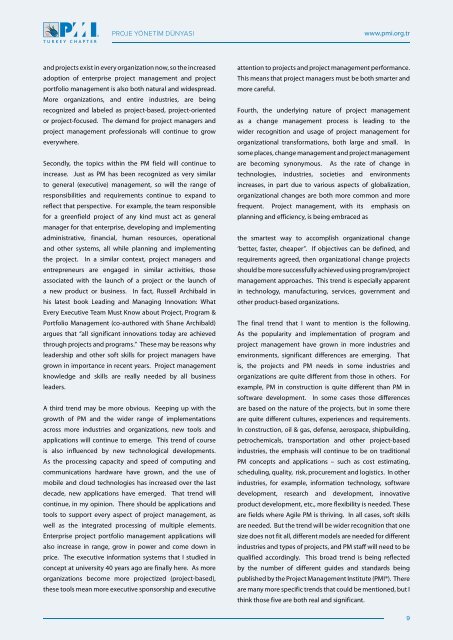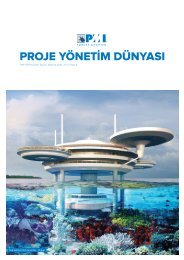PMI-Turkiye-E-Dergi-15-02
PMI-Turkiye-E-Dergi-15-02
PMI-Turkiye-E-Dergi-15-02
You also want an ePaper? Increase the reach of your titles
YUMPU automatically turns print PDFs into web optimized ePapers that Google loves.
PROJE YÖNETİM DÜNYASIwww.pmi.org.trand projects exist in every organization now, so the increasedadoption of enterprise project management and projectportfolio management is also both natural and widespread.More organizations, and entire industries, are beingrecognized and labeled as project-based, project-orientedor project-focused. The demand for project managers andproject management professionals will continue to groweverywhere.Secondly, the topics within the PM field will continue toincrease. Just as PM has been recognized as very similarto general (executive) management, so will the range ofresponsibilities and requirements continue to expand toreflect that perspective. For example, the team responsiblefor a greenfield project of any kind must act as generalmanager for that enterprise, developing and implementingadministrative, financial, human resources, operationaland other systems, all while planning and implementingthe project. In a similar context, project managers andentrepreneurs are engaged in similar activities, thoseassociated with the launch of a project or the launch ofa new product or business. In fact, Russell Archibald inhis latest book Leading and Managing Innovation: WhatEvery Executive Team Must Know about Project, Program &Portfolio Management (co-authored with Shane Archibald)argues that “all significant innovations today are achievedthrough projects and programs.” These may be reasons whyleadership and other soft skills for project managers havegrown in importance in recent years. Project managementknowledge and skills are really needed by all businessleaders.A third trend may be more obvious. Keeping up with thegrowth of PM and the wider range of implementationsacross more industries and organizations, new tools andapplications will continue to emerge. This trend of courseis also influenced by new technological developments.As the processing capacity and speed of computing andcommunications hardware have grown, and the use ofmobile and cloud technologies has increased over the lastdecade, new applications have emerged. That trend willcontinue, in my opinion. There should be applications andtools to support every aspect of project management, aswell as the integrated processing of multiple elements.Enterprise project portfolio management applications willalso increase in range, grow in power and come down inprice. The executive information systems that I studied inconcept at university 40 years ago are finally here. As moreorganizations become more projectized (project-based),these tools mean more executive sponsorship and executiveattention to projects and project management performance.This means that project managers must be both smarter andmore careful.Fourth, the underlying nature of project managementas a change management process is leading to thewider recognition and usage of project management fororganizational transformations, both large and small. Insome places, change management and project managementare becoming synonymous. As the rate of change intechnologies, industries, societies and environmentsincreases, in part due to various aspects of globalization,organizational changes are both more common and morefrequent. Project management, with its emphasis onplanning and efficiency, is being embraced asthe smartest way to accomplish organizational change‘better, faster, cheaper”. If objectives can be defined, andrequirements agreed, then organizational change projectsshould be more successfully achieved using program/projectmanagement approaches. This trend is especially apparentin technology, manufacturing, services, government andother product-based organizations.The final trend that I want to mention is the following.As the popularity and implementation of program andproject management have grown in more industries andenvironments, significant differences are emerging. Thatis, the projects and PM needs in some industries andorganizations are quite different from those in others. Forexample, PM in construction is quite different than PM insoftware development. In some cases those differencesare based on the nature of the projects, but in some thereare quite different cultures, experiences and requirements.In construction, oil & gas, defense, aerospace, shipbuilding,petrochemicals, transportation and other project-basedindustries, the emphasis will continue to be on traditionalPM concepts and applications – such as cost estimating,scheduling, quality, risk, procurement and logistics. In otherindustries, for example, information technology, softwaredevelopment, research and development, innovativeproduct development, etc., more flexibility is needed. Theseare fields where Agile PM is thriving. In all cases, soft skillsare needed. But the trend will be wider recognition that onesize does not fit all, different models are needed for differentindustries and types of projects, and PM staff will need to bequalified accordingly. This broad trend is being reflectedby the number of different guides and standards beingpublished by the Project Management Institute (<strong>PMI</strong>®). Thereare many more specific trends that could be mentioned, but Ithink those five are both real and significant.9



